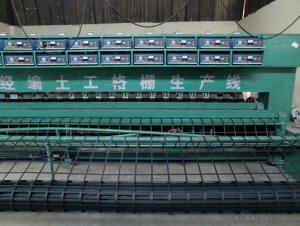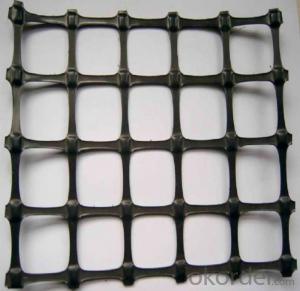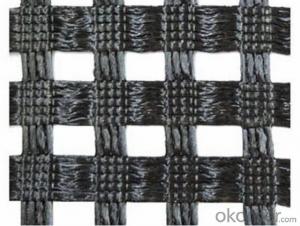Construction Material HDPE Geogrid
- Loading Port:
- China Main Port
- Payment Terms:
- TT or LC
- Min Order Qty:
- -
- Supply Capability:
- -
OKorder Service Pledge
OKorder Financial Service
You Might Also Like
1. Product Description:
Double-direction geogrid is made of high molecular polymer through extrusion, forming and punching before longitudinal and lateral stretching. This chain structure can effectively bear and diffuse forces on soil and is applicable to large area permanent load bearing foundation as a reinforce.
2. Product Characteristic:
1. Enhance earth slope and prevent water loss and soil erosion.
2. Convenient construction saves time and labor, reduce mounting time and
3. Increase the bearing capacity of the roadbed and foundation and prolong their service life.
3.Specification:
1. Tensile strength: 15~100KN/M.
2. Color: black etc.
3.Material: PP/PE.
4. Certificate: CE/ISO9001, 14001
Typical Dimensions mm | ||||||
KN | 2020LKN | KN | 3030LKN | KN | 4040LKN | |
Pmd | 40 | 65 | 40 | 60 | 33 | 54 |
Wmd | 2.0 | 3.3 | 2.2 | 3.3 | 2.3 | 3.5 |
Wld | 2.4 | 4.0 | 2.7 | 4.0 | 2.6 | 4.5 |
Tj | 4.1 | 4.3 | 4.3 | 6.5 | 5.5 | 7.5 |
4. Reference Picture:
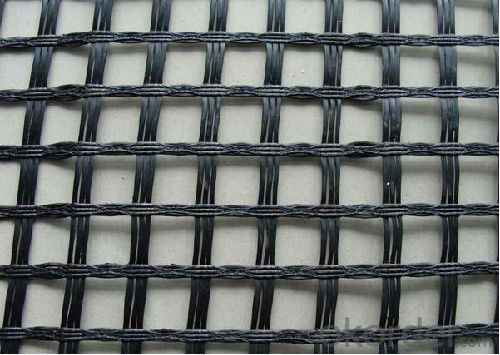
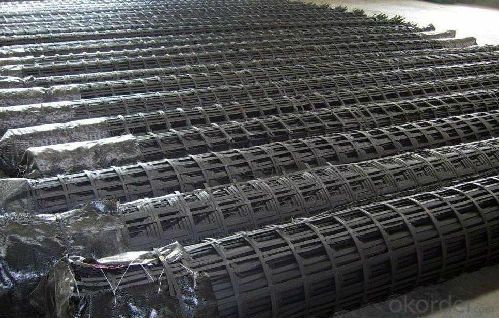

- Q:What is the recommended spacing between geogrid layers?
- The recommended spacing between geogrid layers can vary depending on the specific project and soil conditions. However, in general, a spacing of about 2 to 3 feet (0.6 to 0.9 meters) is often recommended to achieve optimal reinforcement and stability.
- Q:What kind of experiments need to be done to check geogrid
- Review of the general test or the original detection of the project, but the general requirement to double the number of detection. That is, if there is a sample test is not qualified, then the general review is to extract two samples from the original test material to re check.
- Q:Are geogrids suitable for reinforcing concrete slabs?
- Yes, geogrids are suitable for reinforcing concrete slabs. Geogrids are commonly used to enhance the tensile strength and prevent cracking in concrete slabs. They provide additional support and stability, helping to distribute loads and improve overall durability of the slab.
- Q:How are geogrids used in civil engineering?
- Geogrids are used in civil engineering to reinforce and stabilize soil structures. They are typically made of high-strength polymer materials and are placed within the soil to provide additional strength and stability. Geogrids help distribute loads, prevent soil erosion, and improve the overall performance of infrastructure projects like roads, retaining walls, and embankments.
- Q:How do geogrids enhance the stability of landfill slopes?
- Geogrids enhance the stability of landfill slopes by creating a reinforced structure that prevents soil erosion and slope failures. They provide additional tensile strength to the soil, distribute lateral loads more evenly, and increase overall slope stability. Additionally, geogrids help to control soil settlement and improve drainage, reducing the risk of landslides and ensuring long-term stability of the landfill slopes.
- Q:Are geogrids suitable for use in railway ballast reinforcement?
- Yes, geogrids are suitable for use in railway ballast reinforcement. Geogrids provide stabilization and reinforcement to the ballast layer, improving its strength and preventing deformation under heavy loads. They distribute the load more evenly, reducing the risk of settlement and track misalignment. Additionally, geogrids enhance the overall performance and longevity of the railway track by minimizing maintenance and repair needs.
- Q:What are the differences between geogrids and geocells?
- Geogrids and geocells are both materials used for soil reinforcement and stabilization, but they have distinct differences. Geogrids are typically made of high-strength synthetic materials such as polyester or polypropylene, and they are formed into a grid-like structure. They provide tensile strength to soil, preventing lateral movement and improving load distribution. On the other hand, geocells are three-dimensional cellular structures made from materials like high-density polyethylene. They create a honeycomb-like network that confines soil particles, preventing erosion and promoting load-bearing capacity. While geogrids are commonly used for soil stabilization in applications like road construction, geocells are often employed for erosion control and slope stabilization.
- Q:Plastic two-way geogrid hole 4 cm thick, 1 mm wire width of 4 mm
- You say how many grams a square, or how many KN,
- Q:What is the tgsg15-15 geogrid
- The single belt is formed by the longitudinal and horizontal spacing or the clamping arrangement, and the welding joint is formed by adopting the welding technology of special strengthening bonding to weld the joint.
- Q:Geotextile manufacturers which good? Where is the best geotextile, geotextile manufacturers
- Needle punched nonwoven fabric and PE film composite geotextile:A specification film cloth, a cloth film two, maximum width of 4.2 meters is the main raw material to use acupuncture non-woven polyester staple fiber, PE film by composite, is mainly used for seepage control, applicable to rail, highway, tunnel, subway, airport project. Geotextile manufacturers can choose Wo environmental protection
1. Manufacturer Overview |
|
|---|---|
| Location | |
| Year Established | |
| Annual Output Value | |
| Main Markets | |
| Company Certifications | |
2. Manufacturer Certificates |
|
|---|---|
| a) Certification Name | |
| Range | |
| Reference | |
| Validity Period | |
3. Manufacturer Capability |
|
|---|---|
| a)Trade Capacity | |
| Nearest Port | |
| Export Percentage | |
| No.of Employees in Trade Department | |
| Language Spoken: | |
| b)Factory Information | |
| Factory Size: | |
| No. of Production Lines | |
| Contract Manufacturing | |
| Product Price Range | |
Send your message to us
Construction Material HDPE Geogrid
- Loading Port:
- China Main Port
- Payment Terms:
- TT or LC
- Min Order Qty:
- -
- Supply Capability:
- -
OKorder Service Pledge
OKorder Financial Service
Similar products
New products
Hot products
Hot Searches
Related keywords
